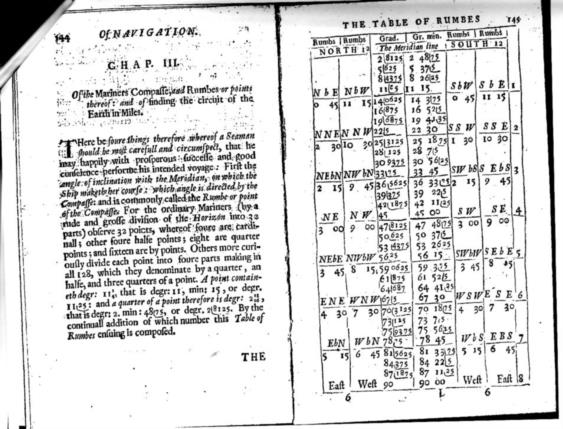
NavList:
A Community Devoted to the Preservation and Practice of Celestial Navigation and Other Methods of Traditional Wayfinding
Re: napier and logarithms
From: George Huxtable
Date: 2009 May 30, 12:29 +0100
From: George Huxtable
Date: 2009 May 30, 12:29 +0100
Paul Hirose pointed us to a Google of Briggs book on Logarithms, of 1624. The Latin text, in that, defeats me, but I was interested in Briggs' notation for decimal parts of numbers, which were quite a new concept in those days. Until then, the Western world had relied on fractions. The "decimal-point" (or in Europe, "decimal-comma") hadn't yet come into use, and mathematicians denoted decimal numbers in whichever way they thought best. Briggs denoted the integer part of a decimal number by slightly larger type; then the decimal part, in smaller type, was underlined. In the attachment you can see how the printer has set it out, by inseting a row of underline characters, rather raggedly, into his block. My interest comes from reading an account by Oughtred of his circular slide rule, of about 1630, which he called his "Circles of proportion", comprising 11 concentric scales, finely inscribed on a brass disc 18 inches diameter. The book has an addendum concering his navigator's version, which is the instrument held at the Museum fot the History of Science in Oxford. That version has a two-turn scale of meridional parts, two turns (decades) of log sines (of angle from half-a-degree to 90), and four decades of log tans, from half-a-degree to 89.4. It was intended for handling the navigational problems of rhumb-line sailing, but not (as far as I can make out) to handle the great-circle calculations that the Bygrave is designed for. Nevertheless, I imagine that with a bit of fiddling, by taking complements of angles, a similar 3-step process to that used by the Bygrave might be implemented. But all that is by-the-way. What I wanted to ask about concerns a translation from his original Latin of Oughtred's 1632 book about his Circles of Proportion. It's the second, corrected, translation, this one by Arthur Haughton, of 1660. It's been digitised, by EEBO (Early English books online) but only available to subscribers, such as university libraries. And my question has little to do with navigation itself, but with Oughtred's notation for decimals, which is, I think, the same notation that was being used in the earlier documents of 30 years before, just a few years after Briggs. Oughtred goes to some trouble to explain about decimals, and his notation involves drawing an L-slaped line, the vertical stroke coming beteen the units and tenths digits, when it bends to the right to underline all of the decimal-part. You can see many instances in the attachment, oughtred.jpg. What I found so interesting was that all these L-shapes differ, noticeably. Of course, you expect the horizontal stroke to be of different length, for differing numbers of decimal digits, but it's more than that. Sometimes, the bend of the L is sharp, in others, it's rounded. Sometimes, the "horizontal" arm is casually sloping, by different amounts. I wondered how these marks had been put into my copy, and indeed, whether they had been laboriously drawn in, in manuscript, after printing. By a stroke of luck, the museum happened to have a second copy of that same edition. [It's hard enough to lay hands on a 17th century book, never mind finding two identical copies in the same place] And indeed, those L marks, in the two copies, were identical; they had indeed been printed. So now, at long last, I get to my question. HOW were they printed? The museum librarian hazarded a guess that the printer had somehow inserted bits of bent wire into his block, to pick up the ink and transfer it. But how would they be held in place? Does anyone know enough about printing to make a guess? Life, for printers of such technical matters, must have got a lot easier once the decimal point came in. The attachment itself is interesting to navigators, in its content. It shows the four quadrants of the compass, each divided into 32 "rumbes", but those angles are precisely split up, and given in two alternative decimal notations. Either as decimal degrees, starting at 2.8125 degrees, or as degrees and decimal-minutes, starting at 2 degrees 48.75 minutes. Oughtred was a long way ahead of his time, in decimalisation. George. contact George Huxtable, at george@hux.me.uk or at +44 1865 820222 (from UK, 01865 820222) or at 1 Sandy Lane, Southmoor, Abingdon, Oxon OX13 5HX, UK. --~--~---------~--~----~------------~-------~--~----~ Navigation List archive: www.fer3.com/arc To post, email NavList@fer3.com To , email NavList-@fer3.com -~----------~----~----~----~------~----~------~--~---
File: 108454.briggs.doc







